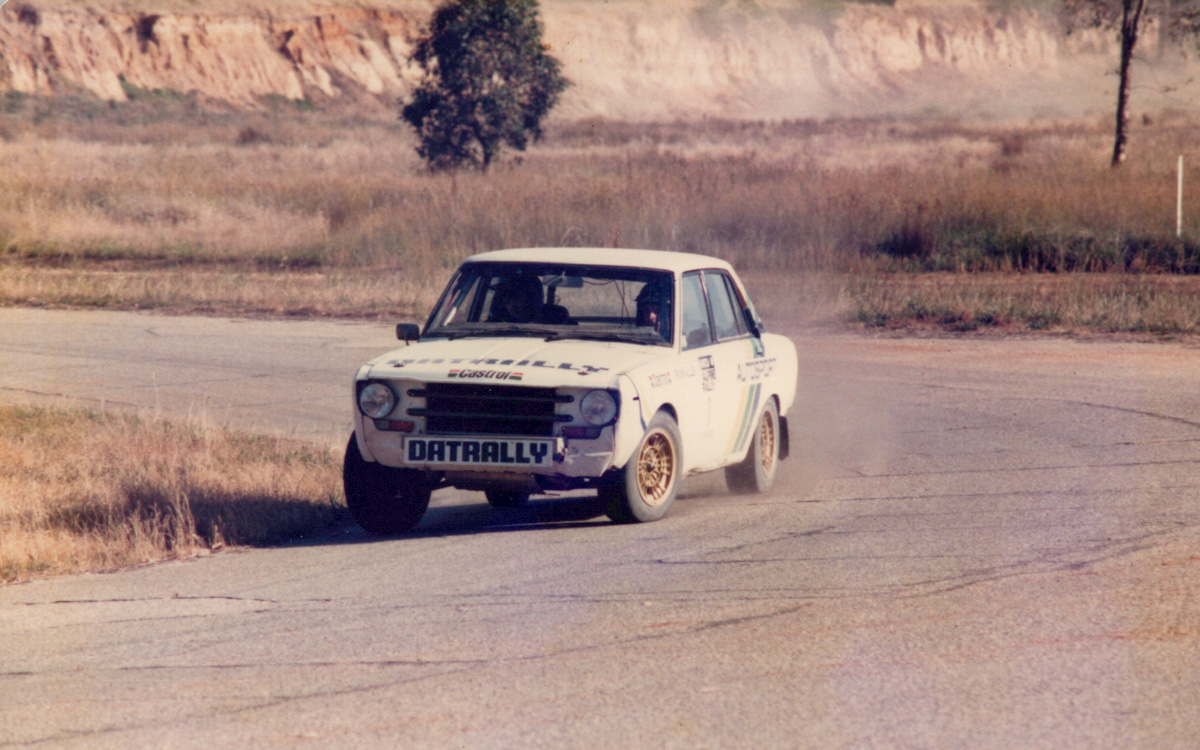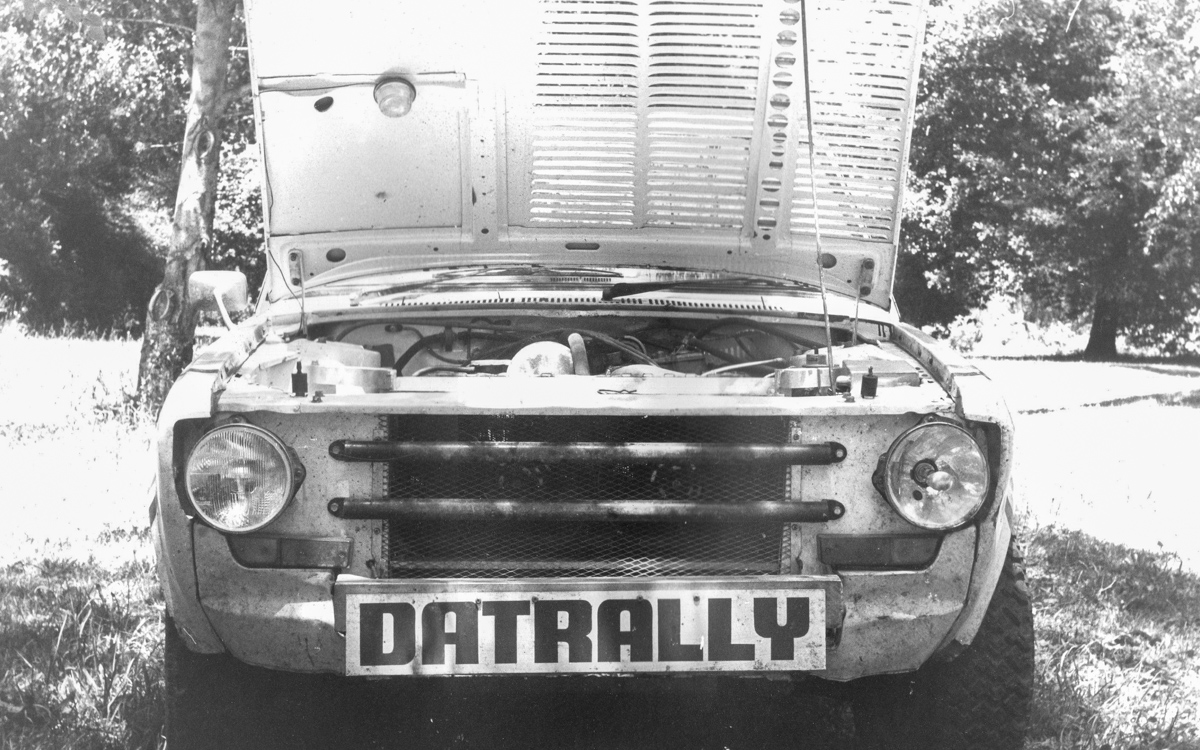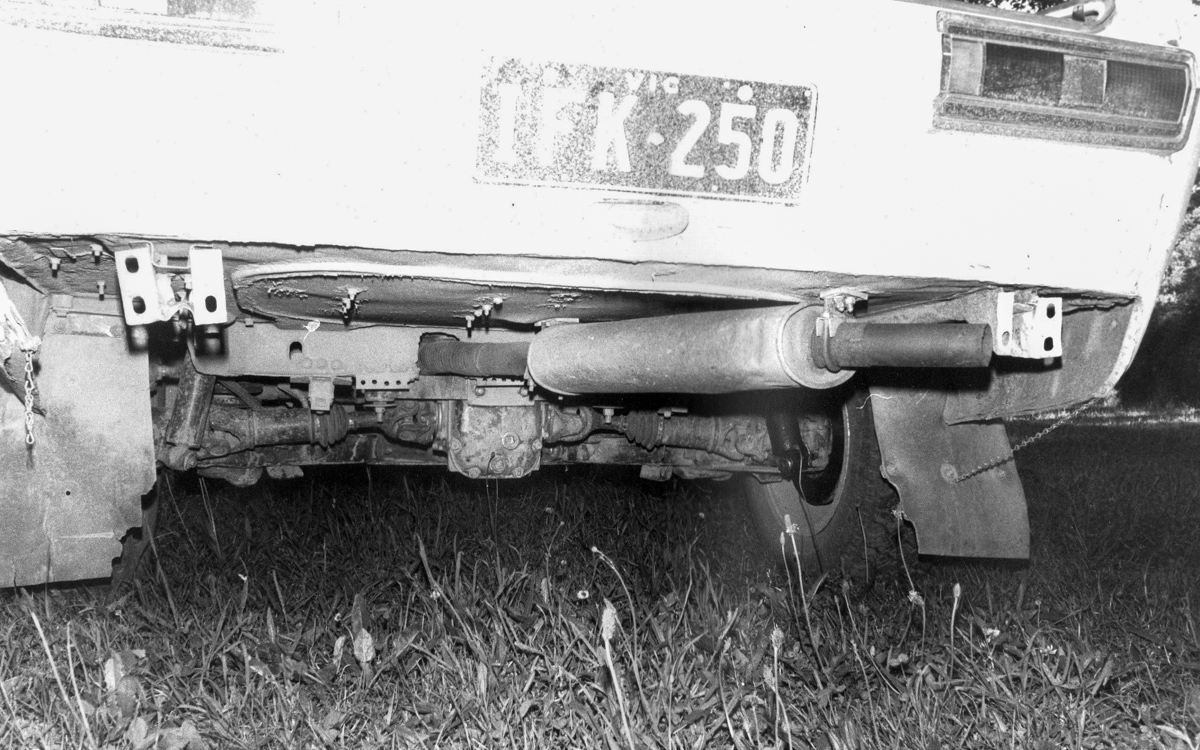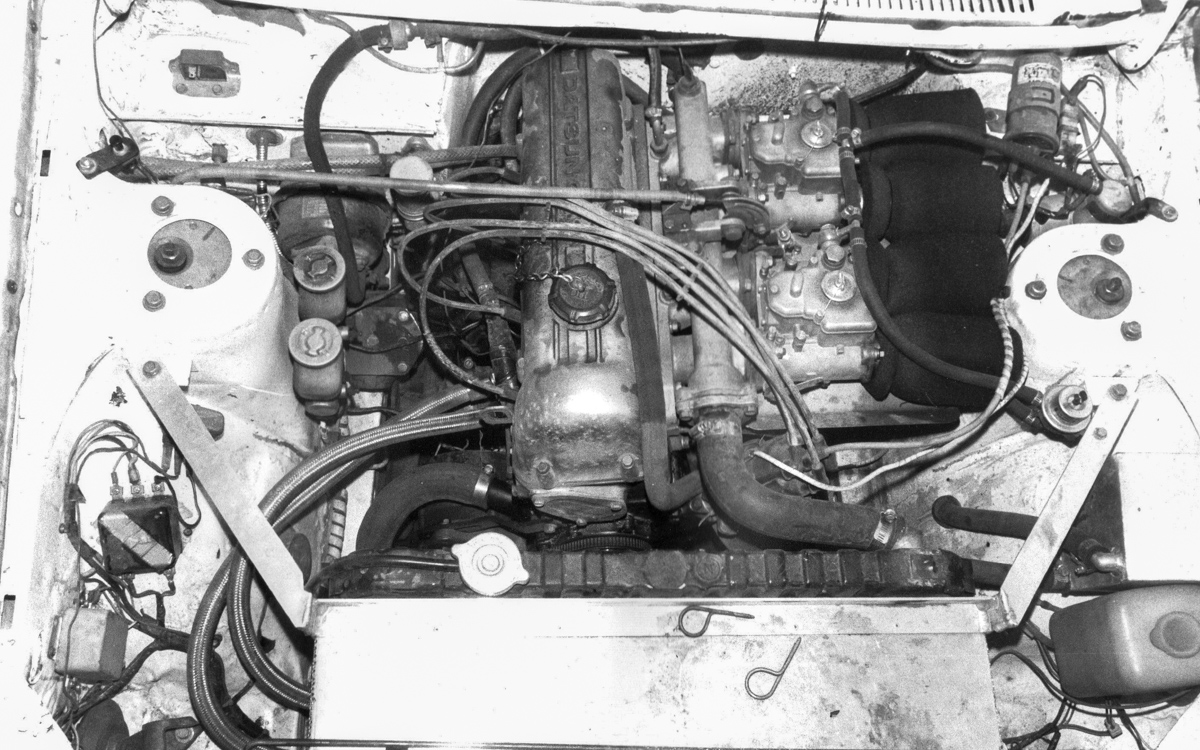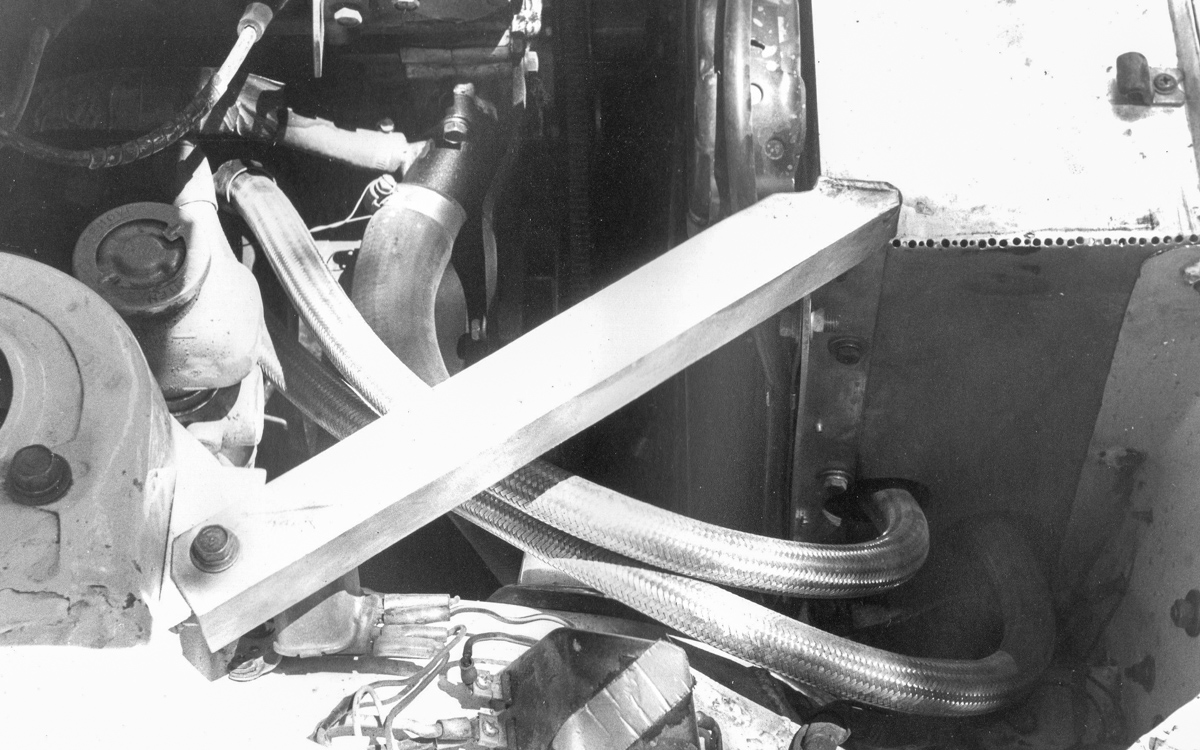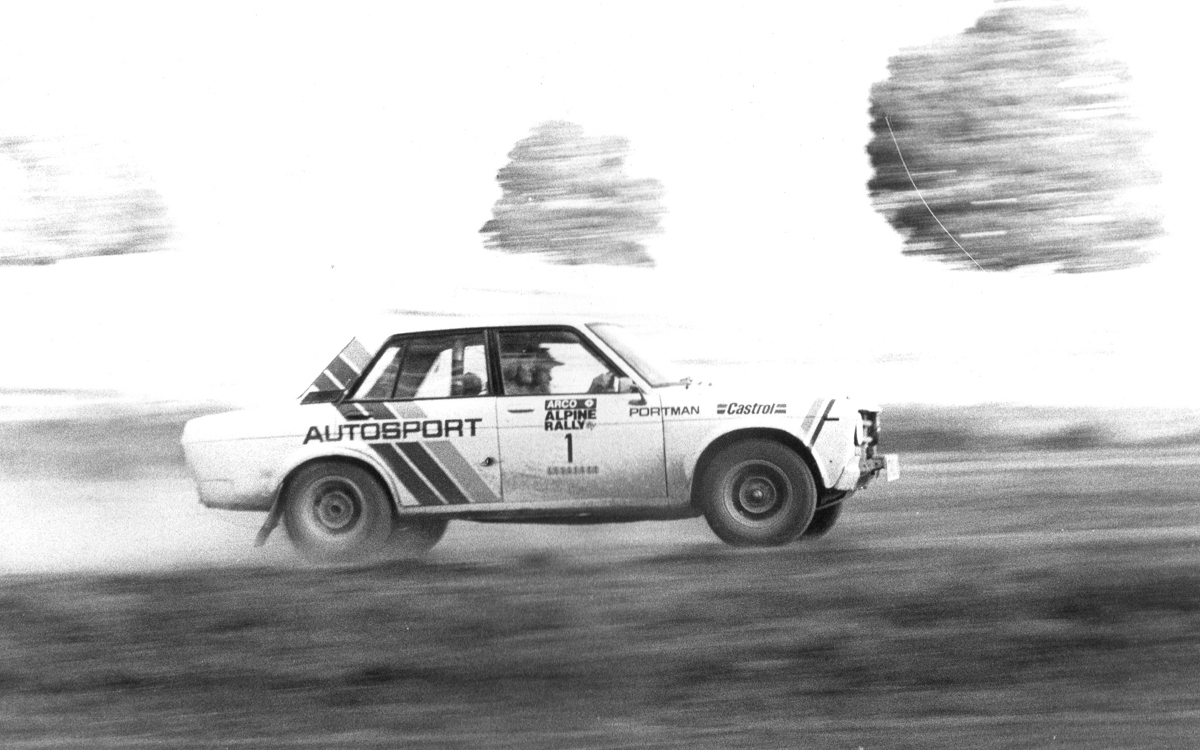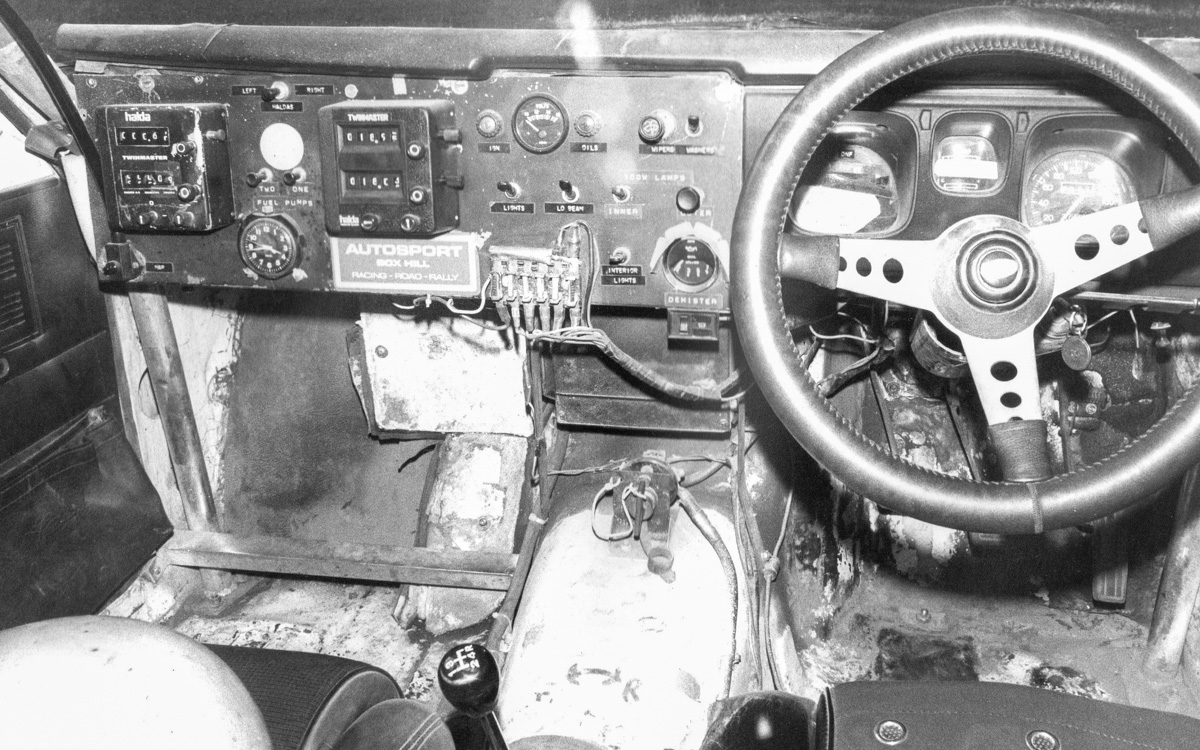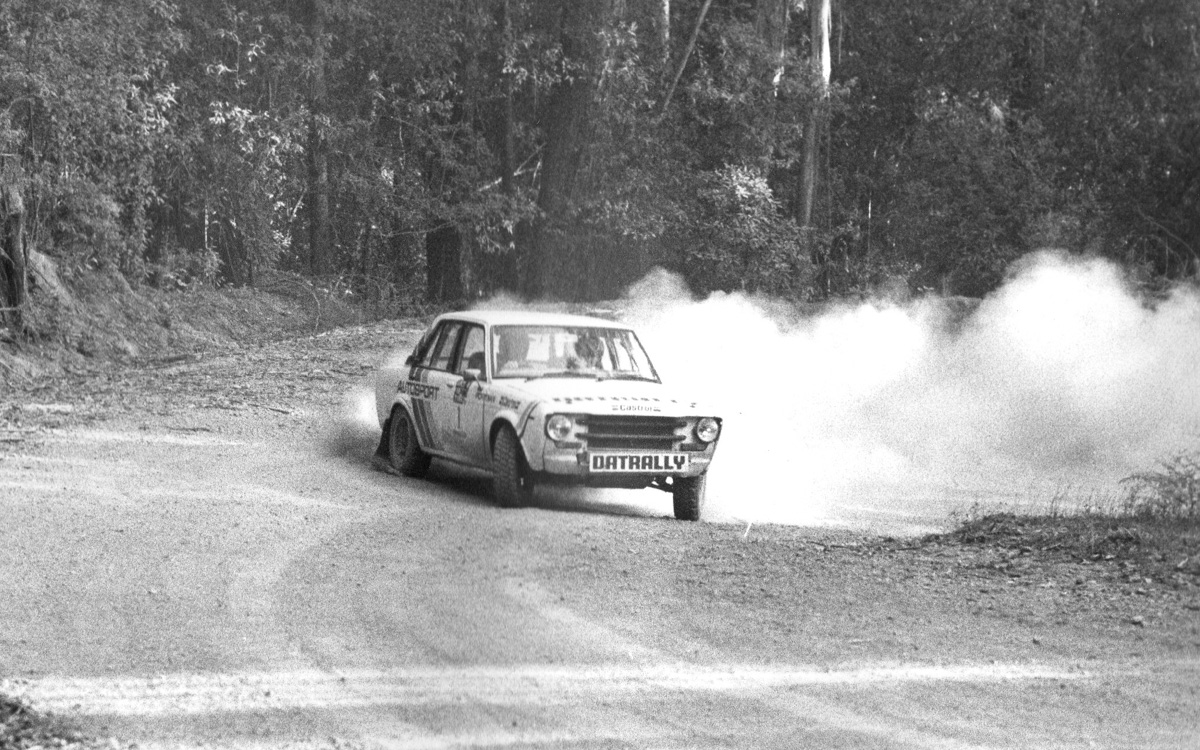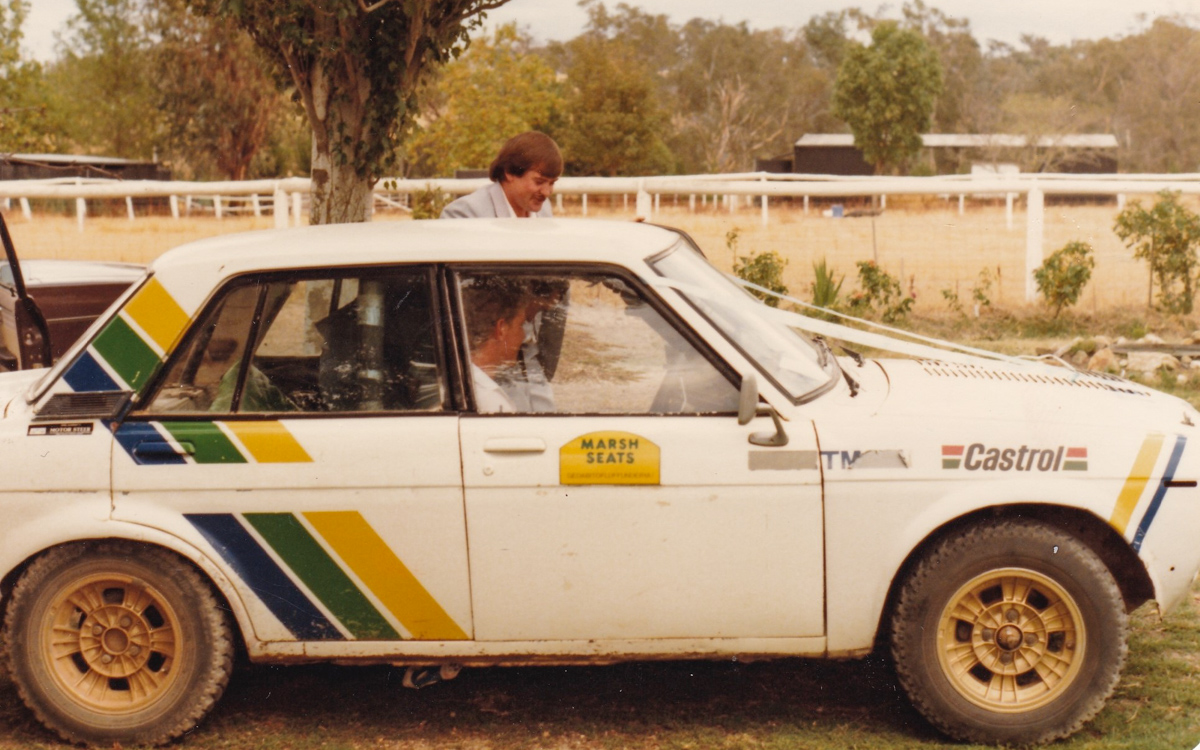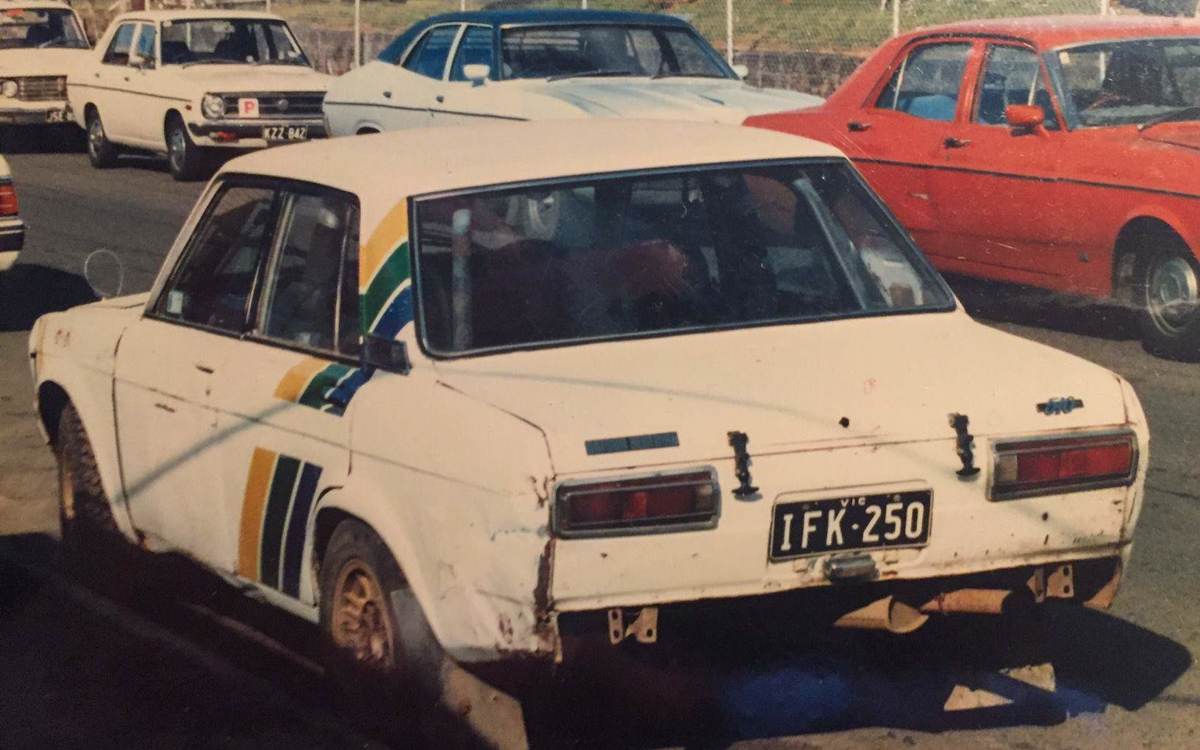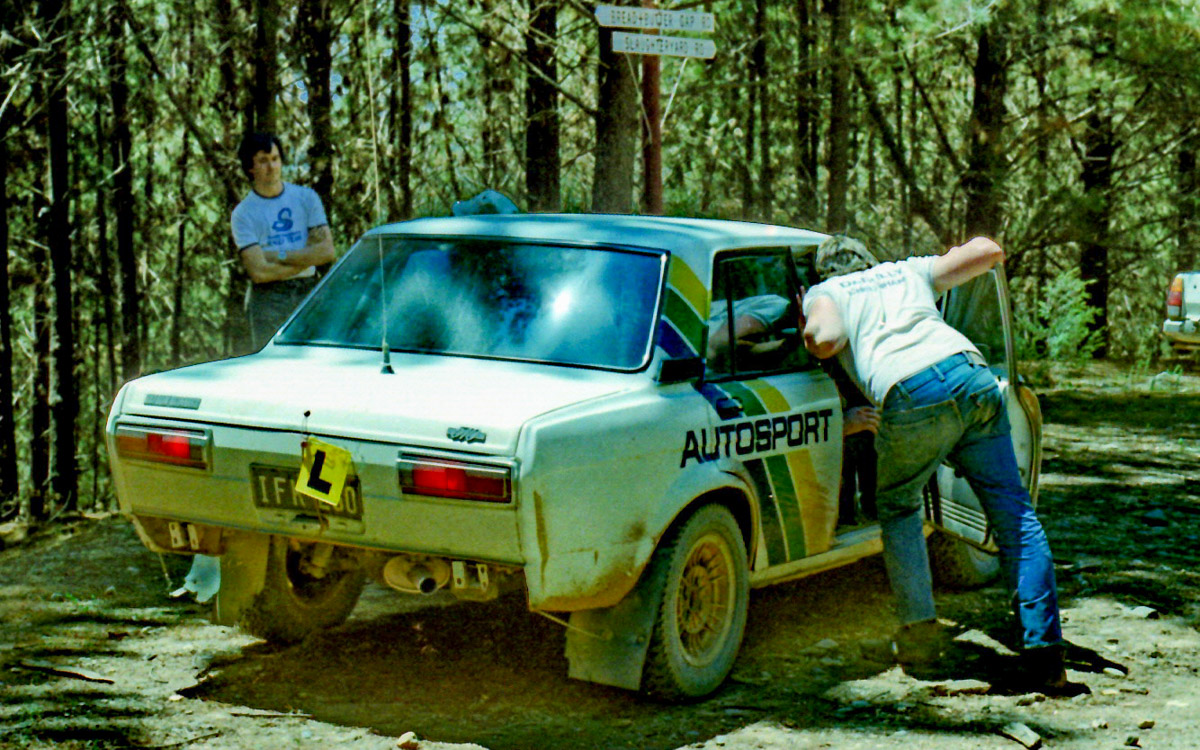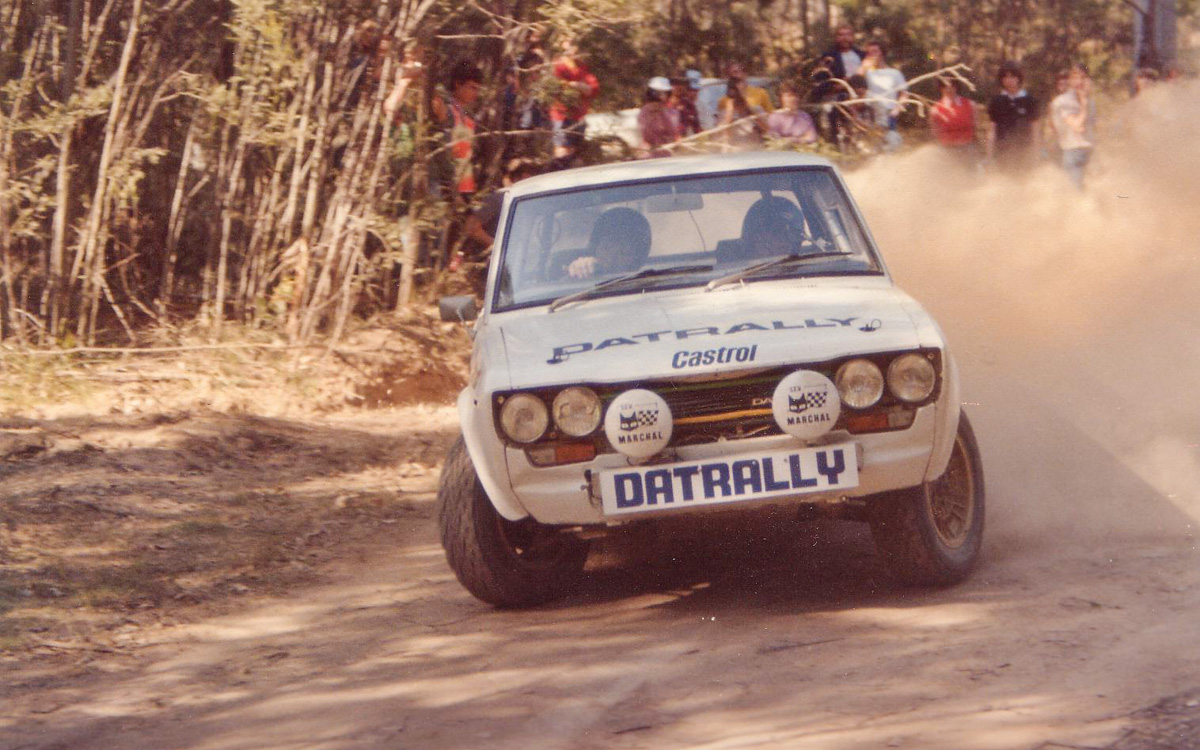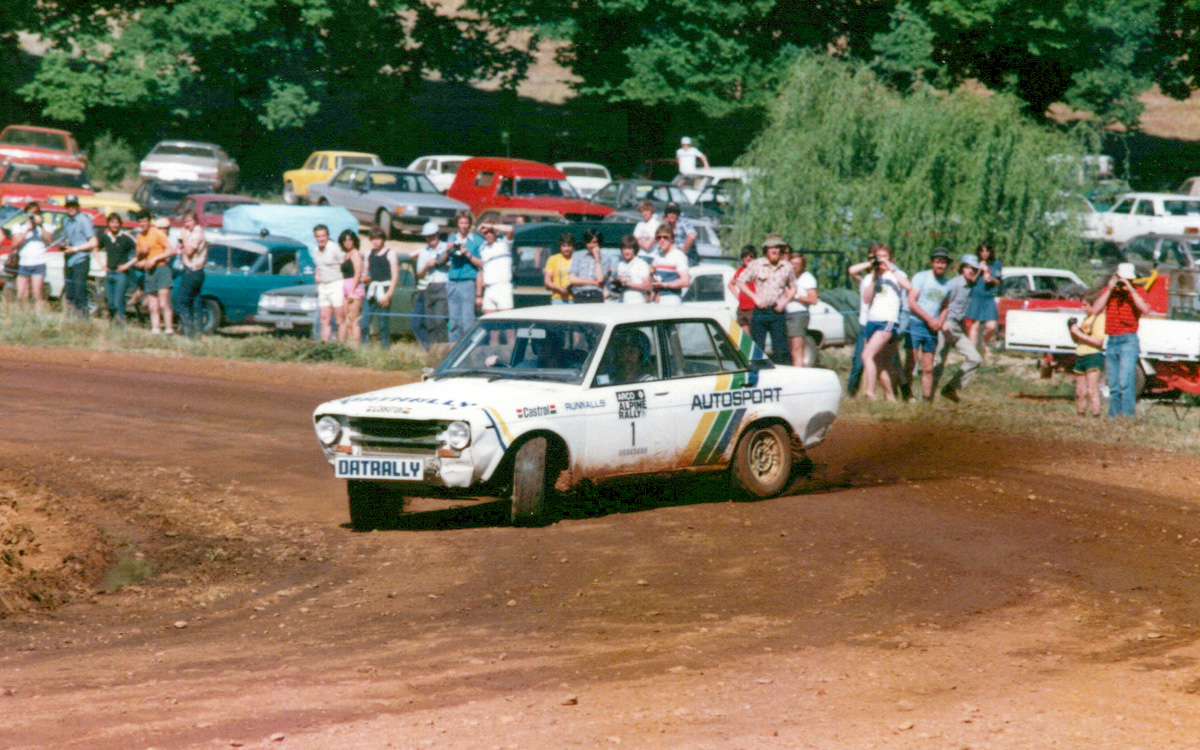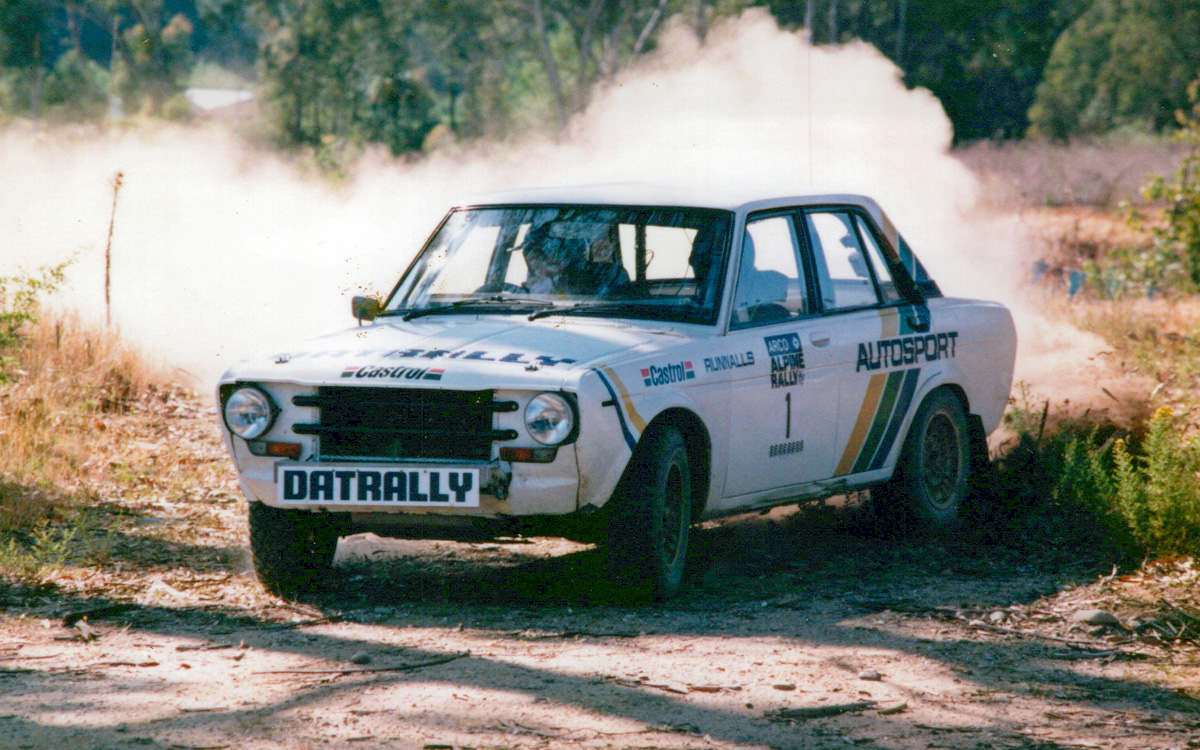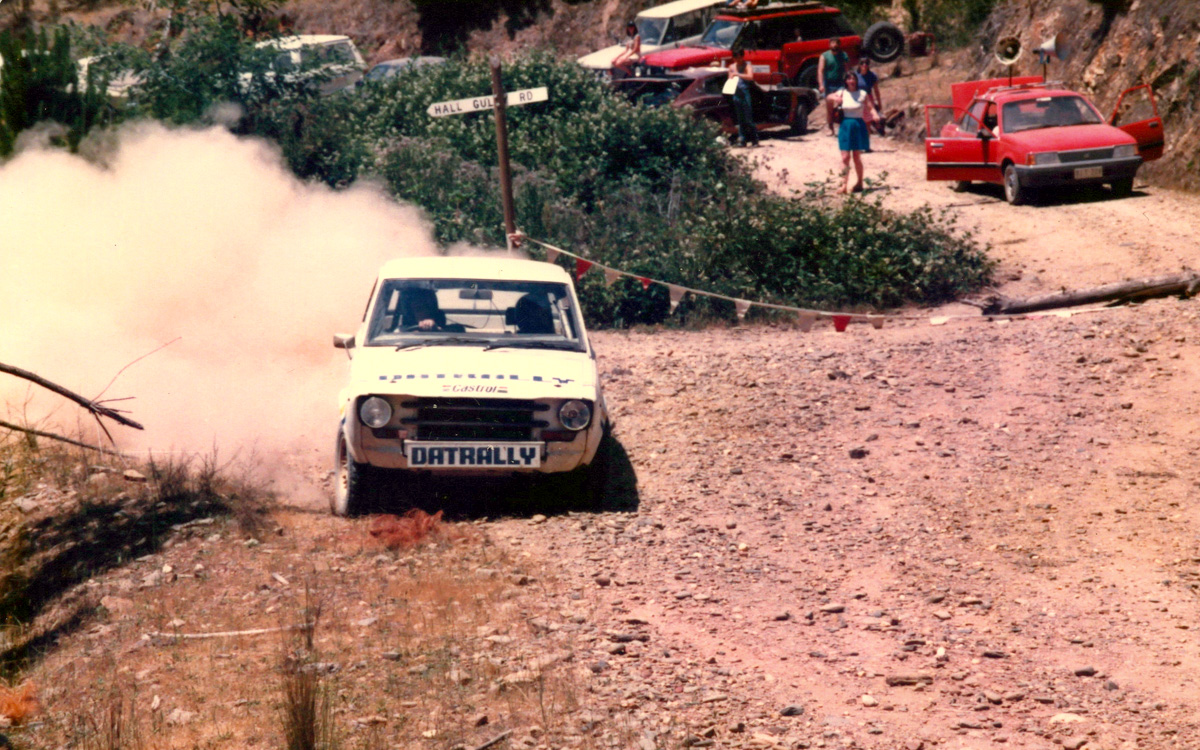They claimed the Australian Rally Championship in a Datsun Stanza as a fully fledged member of the Datsun Rally Team; the Victorian Rally Championship, driving John Armitage’s Datsun 200B and the Victorian Trials Championship in our old friend IFK 250 “the Grunter”.
After a “last harrah” at the 1981 Alpine Rally, in which the Datsun Rally Team entered three works Stanzas… and Geoff came out on top… the Datsun Rally Team was disbanded and the three Stanzas were err… “sold” off. Geoff Portman was not one of the lucky recipients.
There was indeed some late night head scratching going on at Datrally Developments over Christmas 1981, before a good dose of hard work and some clever thinking put things back on track for 1982.
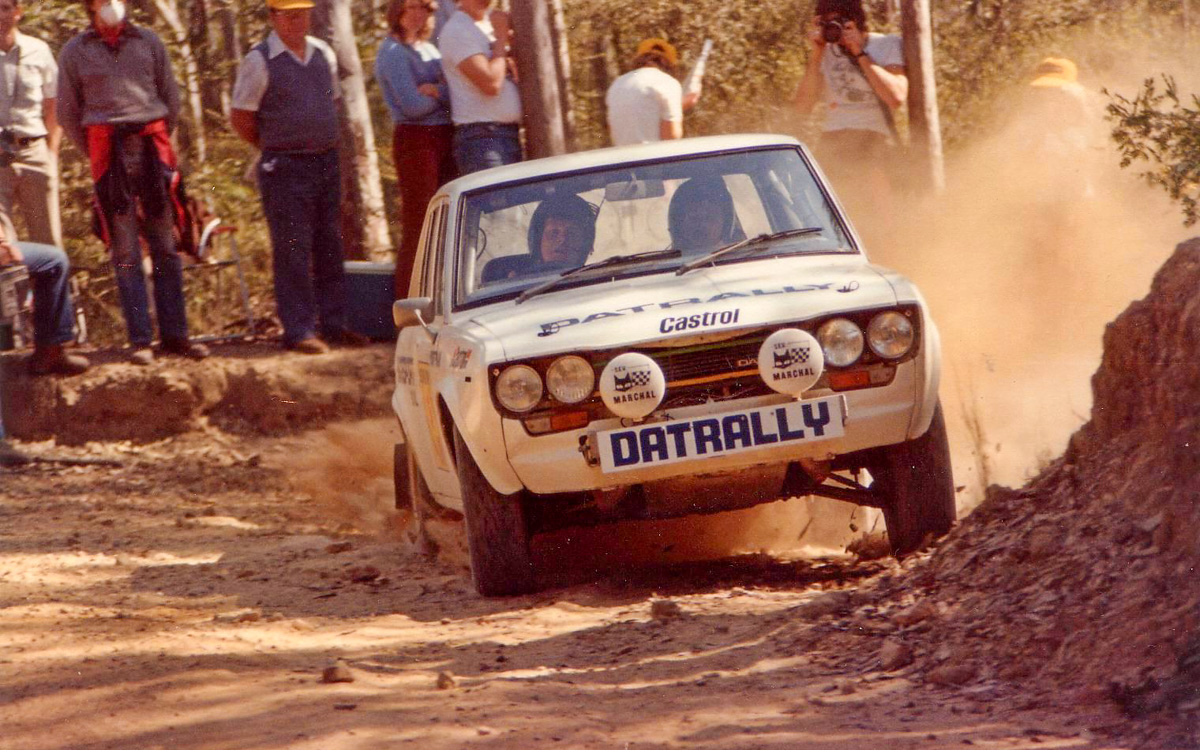
Without a works team and consequently without a works drive in 1982, the Grunter was brought back into the front line.
A head-to-toe refreshment over summer was on the cards for IFK and some more Collins engine development was undertaken, including additional crankshaft stroke to result in a capacity of 2340cc, which saw Les crack 232 bhp on the dyno for the first time!
There were no other technical specification changes or improvements to the car, as there really weren’t any to do – it was already modified and improved about as much as could be realistically achieved with a Datsun 1600, bearing in mind what it was to be used for.
Another downside of not having a factory rally drive was that the bills would again be paid by the car owner.
IFK 250’s biggest competition in 1982 was the Caroline O’Shannessy owned Group 4 Fiat 131 Abarth driven by Greg Carr and Fred Gocentas. An ex-works car, it had been driven by Walter Rohrl and had won the 1980 Rally of Portugal. Despite predictions to the contrary, the Fiat proved to be reliable and fast. But Geoff and Ross in the Grunter were quicker and the pair made it two Australian Rally Championships in a row by the end of the last event of the year, the ARCO Alpine Rally.
The ARC events in 1982 saw wins for Geoff, Ross and IFK 250 in the Sunday Times Safari in West Australia; the Dunlop 2GO in New South Wales; the Commonwealth Motors Rally in Broken Hill, and the final round, the Alpine Rally, in Victoria.
As well as the ARC rounds, IFK 250 contested the Castrol Stages (nee Castrol International in Canberra) and a non-championship rally in Tasmania, the Fairford Forest Stages.
Twigger recalls the Tasmanian event with some disdain. “The organisers were very parochial and (in his opinion) really did not want a foreigner to win the event, even though they invited us down there and were happy to have us. Geoff managed equal first despite it all.
“The Tassie passage control guys at the Fairford Forest Stages in Tasmania claimed Geoff and Ross never passed by them. It was bullshit as we were waiting there as an infield observation to ensure there was no issue. They were using sticky dots attached to the road card at Passage Controls and at the end of the control one of the dots was missing. But we found the dot on the floor and proved he did the route. But they penalised Geoff anyway.”
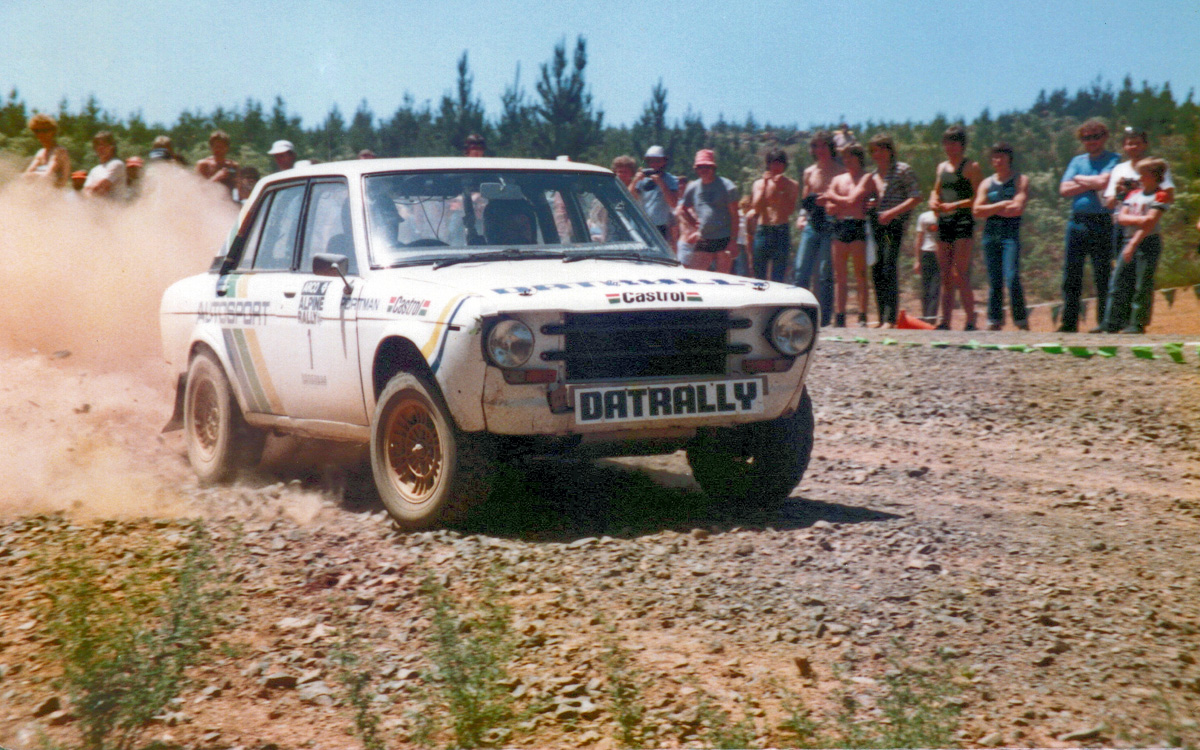
A tyre-ing problem
As an anecdote for the Fairford Stages in Tasmania, to save a few bucks on tyres – given Geoff was paying the bills – the Datsun Rally Team, which were now Nissan Race Team, had a heap of old English “Avon” Rally tyres at Braeside, leftover from “god knows what past event or reason”. Perhaps from some old Southern Cross testing sessions, which used to be carried out in Mt Disappointment, north of Melbourne.
There were certainly none of the special works “thick walled” compound Dunlops, with shredded foam rubber granules in the inner Tubes to seal small puncture holes, available. They had all gone back to Dunlop at end of 1981, but Geoff and the boys “scored a few, though.”
Any good Dunlops Geoff had accumulated (either purchased, or the “end of 1981” stocks) were reserved for the 1982 ARC campaign as the Grunter positively “ate the bloody things.”
Anyway, back to the Avons. Twigger continued: “We took the Avons to Tassie. They were rubbish. The bloody things went flat at the sight of a stone.” Obviously designed for smooth shire laneways in the UK.
In summing up the tyres, Twigger reckoned: “They had countless flat tyres. Otherwise they would have won the event by hours!”
Punctures are punctures and easily fixed, but Twigger suggests that by far the most devastating thing ever that happened to the Grunter was done by the dock wharfies in Melbourne on its return from Tasmania.
“In those days the wharfies demanded that they drove all vehicles onto and off the ship.
“So Grunter got onto and off the ship without dramas on the trip from Melbourne to Tassie, despite having an unfamiliar (to the wharfies at any rate…) 5-speed selector pattern on the works gearbox.” (first gear was to the left and back)
“But on the way back, whoever managed to drive the Grunter onto the ship for the return turned off the battery kill switch and the switch for the fuel pumps, which was on the transmission tunnel, in front of the gearstick.
Problems with standard parts
“When the ship got to Melbourne the wharfies couldn’t start Grunter. So the wharfies decided to tow it off the ship with a tractor and ‘tow start’ it, thinking the battery was flat (not knowing about fuel pumps) so they could drive it around.
“So they roared off under tow by the tractor with a tow strap/chain around the thick aluminium light bar. They threw it into what they thought was 1st gear (but actually reverse on the works Option 1 ‘box) and dumped the clutch.
“It tore the centre out of the ‘indestructible’ works clutch plate and horribly bent the light bar. Hard to imagine the forces involved to do that. Never thought it would be possible. I thought it would just lock up and flat spot the back tyres dragging it.
“The Grunter was mortally wounded and wasn’t going anywhere. All of that damage had to be repaired and other components checked before the next ARC event in 1982, the Lutwyche Shopping Village Rally in Queensland only a few weeks later. We were lucky.”
But then memories of IFK 250 came back and a smile touched Twigger’s lips. “The Grunter was a special car. None of the parts were standard off the shelf bits, they were all rally built specials, with tweeks, different steel, special strengthening, special gas shocks, drilled front stub axles for the Halda cables and the like. Lots of the bits looked standard but weren’t on close inspection.
“So we didn’t really have to do any suspension work-arounds or refinements. Just as well, as we were very inexperienced then.
“I guess this was part of the reason why the Grunter was so inherently reliable over the years. We had very few component failures or breakdowns, except where parts were worn excessively, awas a modified bit or we used ‘after market’ stuff that just wasn’t up to the task.
“Look at the examples: 1978 Marchal – rotor button – a modified Bosch part; 1979 Akademos – clutch – an after market non-works clutch plate; 1979 Bega – half shaft – old worn circlip holding shaft in diff; 1979 Alpine – after market engine valves – not a works part and the 1982 Lutwyche – diff mount floor bolts – standard, not works parts.
“IFK 250 was always looked after very well and had the most love and care of any car. It had all the good stuff in it, especially after the ‘78 Alpine win. It was generally very well maintained. Each event it would be stripped and re-built. The body and chassis checked all the time and at each service point. Consequently, it was a very reliable car.”
The only DNF for the 1982 year was in the Lutwyche Shopping Village Rally in Queensland. Those Queensland demons struck again! It was the first ARC of the year – and the first appearance of Greg Carr’s Fiat 131.
The problem? A broken differential hanger pin. Twigger recalled: “It was a standard 1600 one, and had done a lot of events.”
The pins were known to fail, usually when a 180B diff hanger was used instead of a 1600 one, especially when the larger R180 diff was fitted. 180B hangers would fit, but required a fair pressure on the spring to bend it to fit over the pins, putting load in locations where it was not designed to be. Even with a 1600 hanger some tuners would heat it up with an oxy torch to bend it to fit better with an R180. Not a real good idea with spring steel. Twigger summed it up:
“In reality those pins had done a lot rallies. We learned later that you would tie the diff to the floor with a cable in case the bolts or the cross brace failed. We were using a works diff hanger which came with the 710 diff from all the way back in ’78. It was laminated from two really fine pieces of spring steel and was bullet proof and fitted the 1600 body nicely.
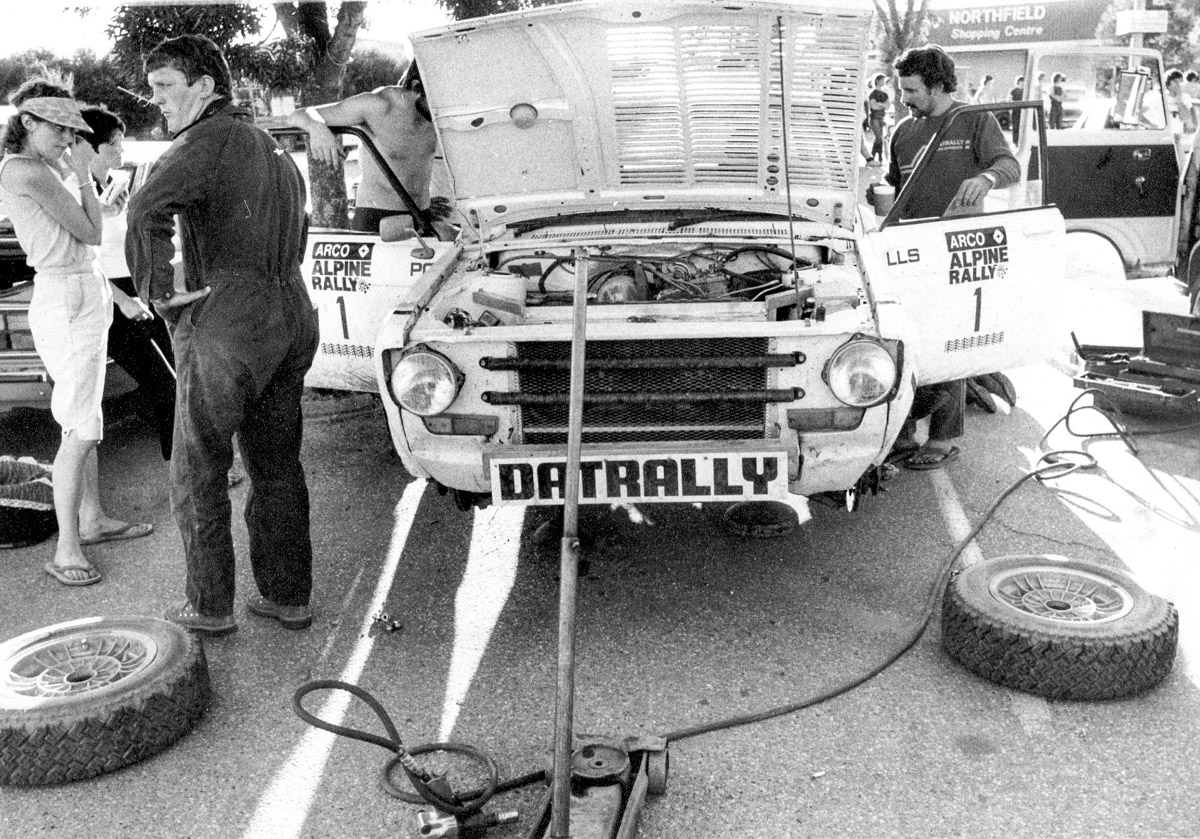
“We also learnt that engine mount breakages could cause big issues, so we also devised wire rope straps tying back the bell housing to the gearbox crossmember and one over the bellhousing behind the engine to stop the engine moving too much on the standard 1600 rubber mounts. You learn from experience.
“But more dramas were to happen in that event. After the diff hanger pin broke, Geoff and Ross were able to carry out some really temporary and fairly radical repairs by attaching a Tirfor winch cable to the back of the diff, and winch it up enough so they could drive to the end of the stage and the service point, where we fixed the pins.”
By the time the repairs were affected the team had used up their late running time and were therefore excluded from the event. But… then the section was cancelled and removed from the results as some of the competitors undertook the stage in the daylight of the next morning – so the question was, how can you be excluded on a section which was deemed not to have been a part of the results? They were a series of official enquiries ruled that they had notified their retirement from the event and therefore could not be included in the placings.
A tough and expensive trip north, that one.
Other than those dramas, it was “normal battle stations”, with IFK 250 taking out the remainder of the ARC rounds and finishing the Championship on 96 points, to second placed Greg Carr on 89
The final event of the year was again the Alpine Rally.
1982 Australian Champions
Tom Snooks, in his excellent book depicting the history of the Australian Rally Championship, noted of the Alpine that year:
“Geoff Portman/Ross Runnalls (Datsun 1600 ‘Grunter’) put the seal on the successful defence of their Australian Rally Championship with a resounding win in the Alpine Rally, with a 15 minute margin over second-paced Doug Thompson/Ron Lugg (Datsun Stanza) and third-placed Steve Ashton/Rosemary Nixon (in another Datrally 1600), 39 seconds away.
Greg Carr, with five previous wins in the Alpine Rally, and Fred Gocentas suffered a broken differential and rear suspension strut and persistent fuel troubles with the Fiat 131 Abarth and finished fourth, nearly five minutes behind third. But nobody could say they didn’t try.
The rally opened in familiar style with the first of three visits to the Bright speedway located at the sports ground, and then in to the forests on the way to a break at Beechworth.
On the second stage Portman spun and stalled to lose time and complained at the break about overheating, and Hugh Bell ran out of fuel.”
The overheating was a concern, as after being increasingly worried about the engine temperature of the Grunter throughout the year, Les found a small workshop in Melbourne that was able to machine stamp a significant number of louvres in the bonnet. This would assist to increase the air flow, help with the under bonnet temperature and reduce the tendency for the car to experience fuel vaporisation, or so it was hoped.
The result was a bonnet with just the best piece of panel beating seen for a long time, and it was apparently quite easy and relatively quick to do.
“Carr lost three minutes when the Fiat’s differential failed, while George Fury/Simon Brown (Datsun 120Y) and Ed Mulligan/Geoff Jones (Ford Escort) both had broken axles but were continuing, and Wayne Bell/Col Parry (Holden Commodore V8) were out, having run an engine bearing.
At Beechworth Portman led from Hugh Bell, Carr, Fury and Steve Ashton. The rally lost Fury just after the break, as navigator Simon Brown was too ill to continue. It was during the afternoon’s run that Carr’s fate was sealed.
Portman’s overheating problem had been traced to a faulty gauge, but now the Fiat was suffering fuel problems with air finding its way into the system and the car stopped more than once, dropping Carr/Gocentas down to 26th place.
The daylight stages ended with a break at Wodonga and Hugh Bell was now only a second behind Portman.
As usual it was a tough night on the return trip to Bright and Portman simply flew, and with thick dust behind him had established a break of five minutes over Bell by the end of the division. Bell’s hopes had not been helped by electrical problems which denied him high beam, as well as rear suspension problems, before putting the car away for the night.
The conditions during Sunday were hotter and dustier than Saturday and Portman drove steadily at the head of the field. Bell had not given up and pressed hard but he was robbed of second place when the Datsun was struck by an untraceable fuel problem.
So, Geoff Portman and Ross Runnalls were the Australian Rally Champion driver and navigator for the second successive year.”
The 1982 Alpine also marked the last championship rally in which Geoff would drive the Grunter in all its finery and with all those works parts, courtesy of John Armitage, Howard Marsden and the 710SSS at the Nissan boneyard four long years ago.
After six years of hard work and a great deal of success and a fair few disappointments along the way, the decision was made to change direction and press ahead with a new, future venture with a Bluebird. This meant a reality check – and hopefully a bank cheque – for Geoff as IFK 250 was put up for sale.
The lucky recipient was Mark Powley. Mark bought the car in 1984 and ran it for two years, primarily in the North Eastern and Riverina Series. He purchased it without a lot of the ex-710 parts, and less an engine. “But with the Enkies!” Mark exclaimed.

Some of the parts which had been removed and replaced by other, less exotic components prior to IFK leaving the Portman stable saw daylight again with the new Portman/Collins weapon, a 1983 Bluebird.
After purchasing the now-historic car, Mark Powley initially fitted his own engine, a L18 and later, for 1985, replaced that with a Les Collins built L20 engine, which he reckons was “good for about 190 bhp”. Along with the new engine was a 5.1:1 ratio LSD, which came as a loan from Phil Pilvern.
“The car was great to drive, it handled totally differently to a normal 1600. It had great turn in and was very controllable, particularly with the 5.1 diff and the good engine. We were beaten in the RNE series only in the last round, by a lousy 40 seconds, which was all my fault when I overshot a corner on the final stage of the last event!” lamented Mark during a phone call about the car.
“When I bought the car the deal came with entry to a Geoff Portman Driving School, which was really helpful. Geoff was a great driver and a wonderful teacher. I learnt heaps from him and then I did another course later on.”
Mark and Ian Enders (who co-drove for Mark for most of the time) did 18 rallies in IFK 250. The old girl was again getting a bit tired and it was time to pass on a true icon of Australian rally history. But Mark retained those original famous number plates. He still has them!
After Mark Powley, the car passed to Steuart Snooks.
Steuart went overseas for a couple of years in 1984 and when he returned, he bought the Grunter from Mark. Interestingly, his relationship with Grunter goes back to the 1982 Alpine, when Steuart took a some pictures of the Grunter which appeared in the Australian Competition yearbook – for which he was paid $75. That was a lot of dollars then.
The Grunter came to Steuart in pretty much the condition which Mark used it, complete with a “reasonable 2-litre engine, but with a standard 240K five speed gearbox and a 3.9:1 open diff”.
“After restoring the bodywork, I added an Option 1 gearbox and a 5.1:1 LSD to the car but only did a very few events in that configuration.”
In all, Steuart drove it in 11 rallies, including the 1986 Alpine, a few Victorian Rally Championship rounds and for its last event in his hands, the only ‘proper’ Rallysprint held in Victoria, along the length of Deep Creek Road, just east of Pakenham in Victoria. Did he have any successes? “Not really, but a lot of fun and great memories.”
1987 was around the time when Group G cars were nearly a thing of the past and in Steuart’s mind the potential resale value of the Grunter was dropping, He opted for a clean swap with Terry Mulholland – a colleague in the wine business. The Grunter for a Mitsubishi Cordia GSR. In hindsight, Terry got the better end of the deal!
From Terry’s ownership of the Grunter not much is known, only that it no longer exists.
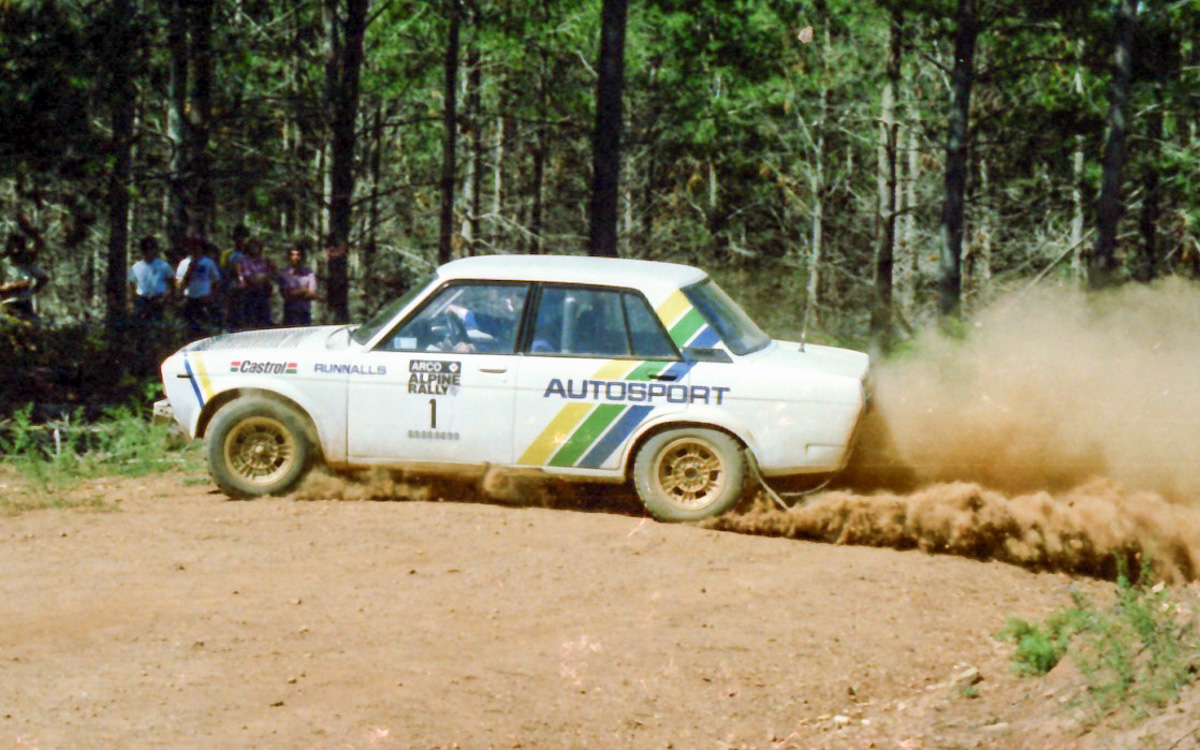
Vale IFK 250, Iteration 3. Aka “The Grunter.” A true piece of Australian rally heritage bites the dust.
So much had IFK 250, in the very capable hands of Geoff Portman, created somewhat of a legend with rally enthusiasts that it engendered a spirit in Victorian jeweller, Glenn Bakker, that one day he would own a Datsun 1600 “just like the Grunter”, as he puts it.
Such was his admiration for the car and determination to achieve his self-declared goal, that Glenn commissioned Les Collins to build a very strong and powerful L20B engine to fit into a 1600, which Glenn calls “the second generation Grunter”.
Glenn’s creation is indeed immaculate in every aspect and is painted in a similar colour scheme and pattern as was IFK 250 in its 1982 Alpine winning heyday.
The workmanship on the car is exemplary and the power output extraordinary – 222 bhp @ 7250 rpm. While the car incorporates very few of any original IFK 250 parts, it has been lovingly built to demonstrate, just maybe, what a 2020 version of IFK 250 may have been.
The rego plate may be the same, but the engine is in the original Datsun position.
In closing, here’s an interesting fact..:
Whilst Datsun 1600/P510s were used (and still are…) in what must have been hundreds of thousands of motor sport competitions, ranging from motorkhanas, circuit sprints, races, rallies, off road events to drifting and dragging, the only National Rally Championship series (in the world) ever won by a Datsun P510 was in 1982, when Geoff Portman and Ross Runnalls won the Australian Rally Championship.
In IFK 250…
Photos in this feature have been contributed by: Bruce Keys, Dallas Dogger, John Lemm, Ken Cusack, David Balfour, Ray Berghouse/Chevron Publishing, Peter Whitten, Ian Long, Tom Kaitler, B Team Rally Media.

